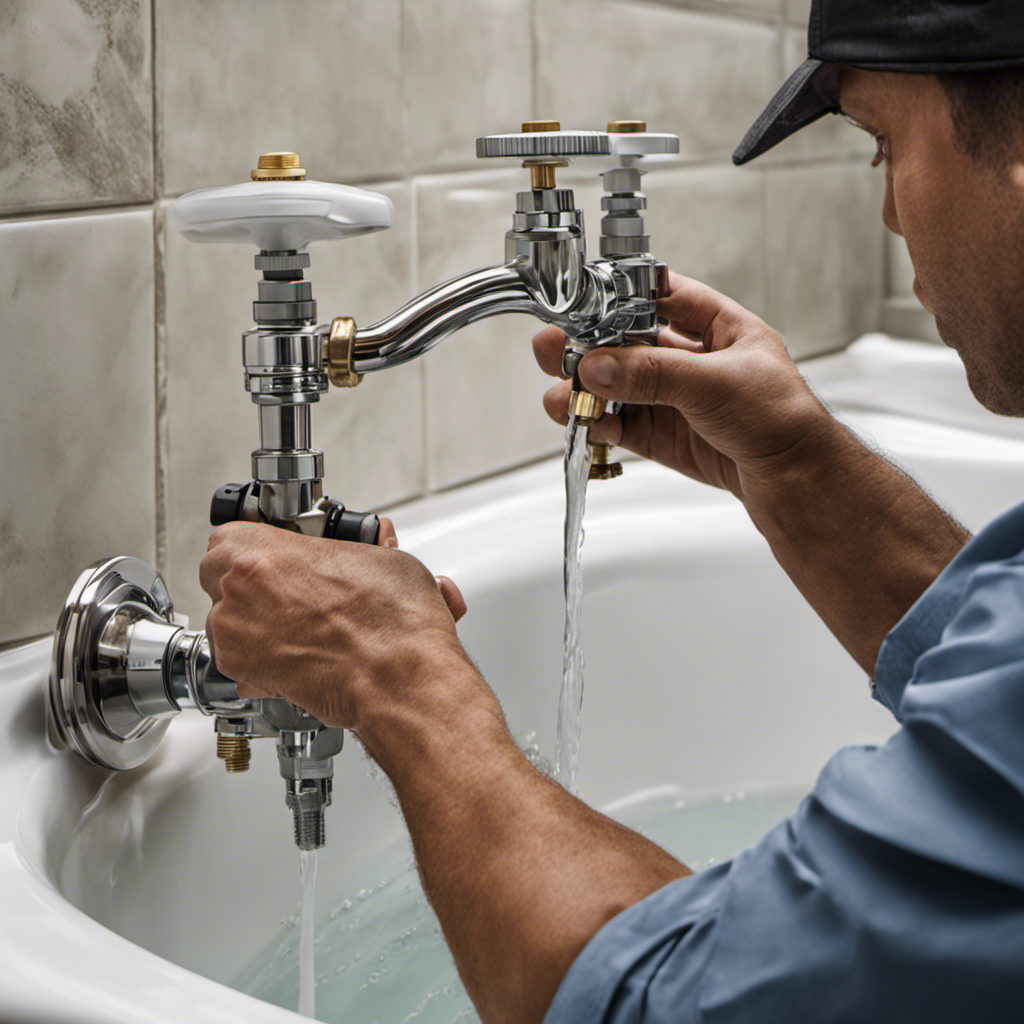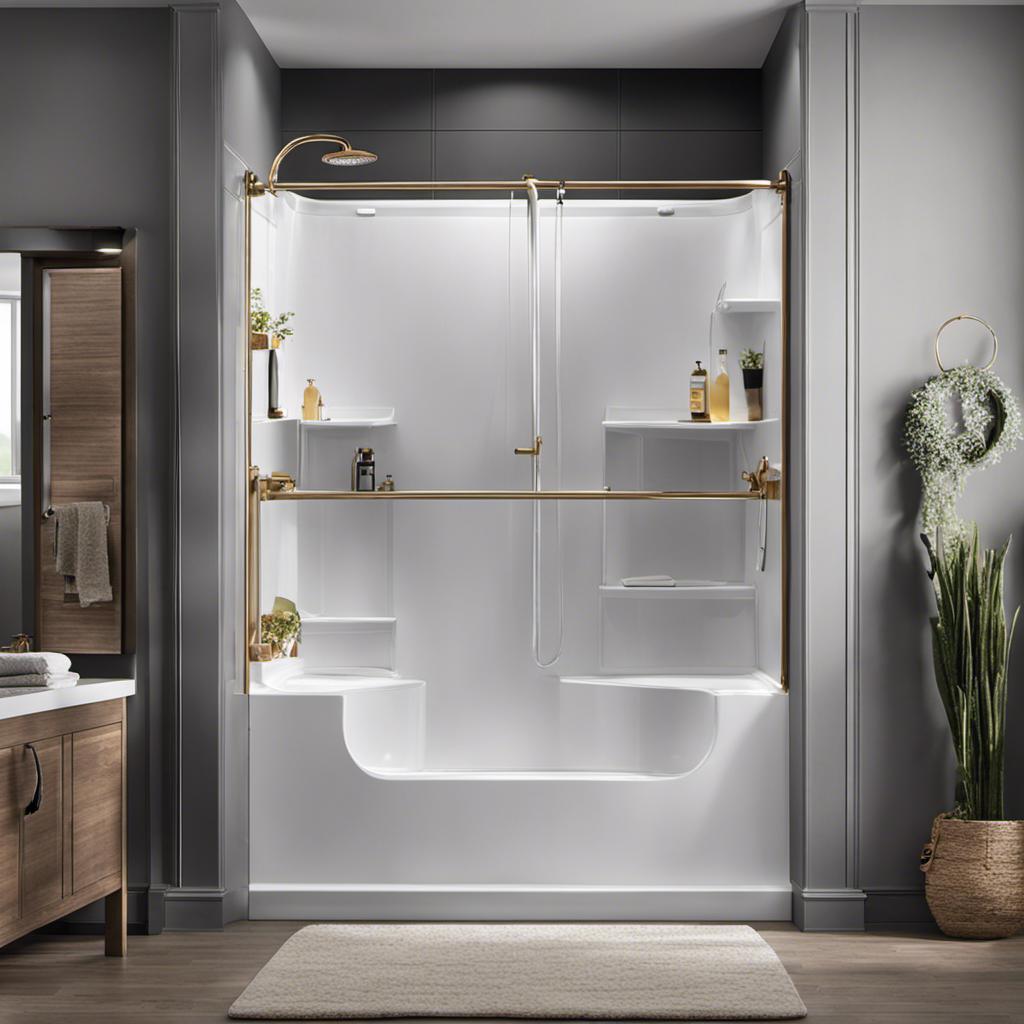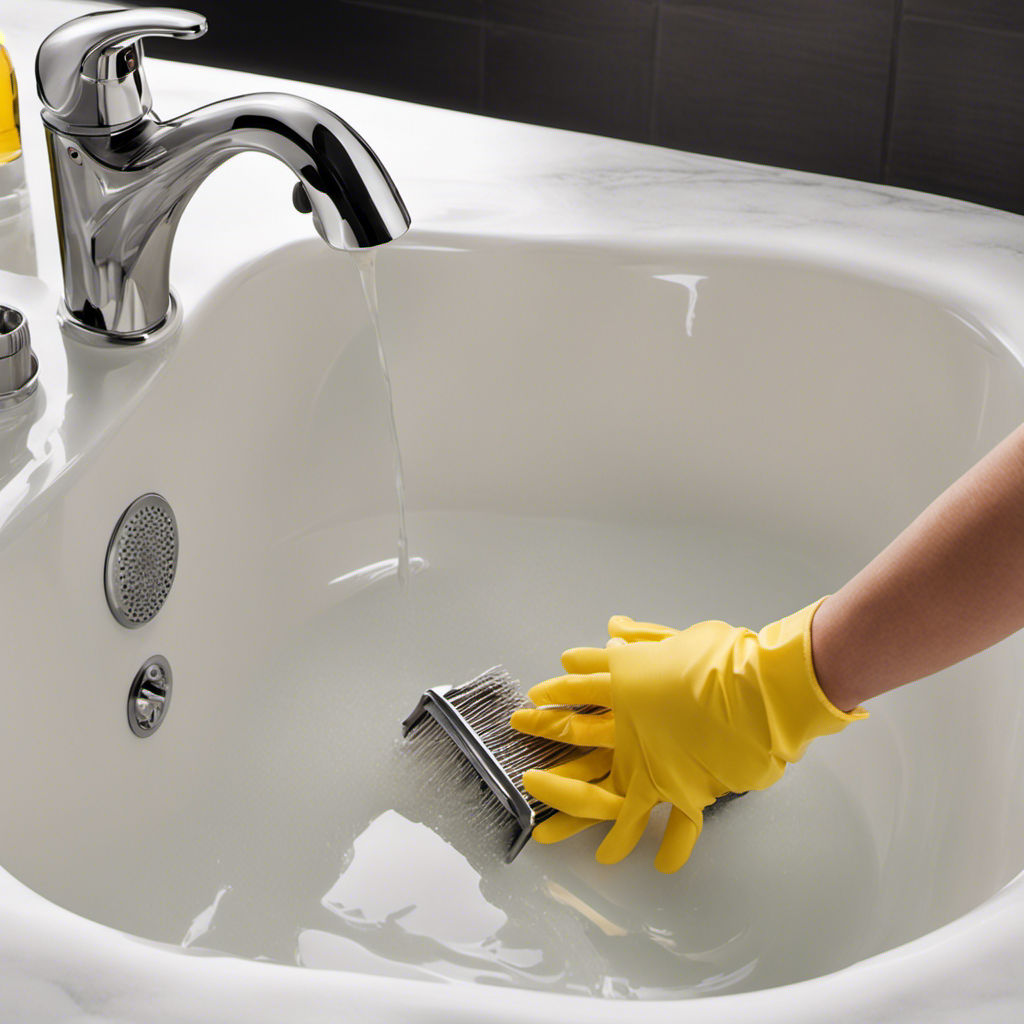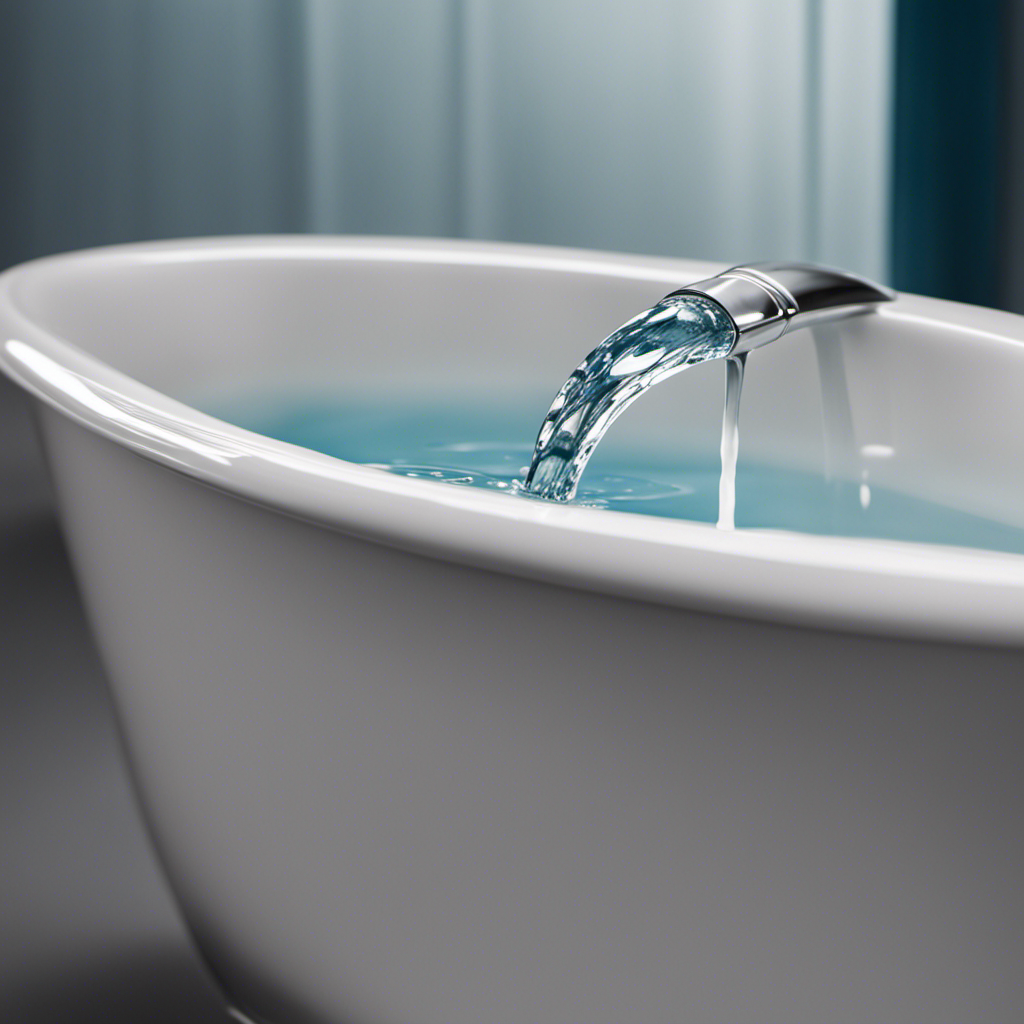I’ve encountered my fair share of annoying pop-up bathtub drains, but fear not! I’ve mastered the art of removing them, and I’m here to share my expertise with you.
In just a few simple steps, you’ll be able to bid farewell to that pesky drain and enjoy a smoothly functioning bathtub once again.
So, grab your tools and let’s get down to business!
Key Takeaways
- The necessary tools for removing a pop-up bathtub drain include pliers, a screwdriver, a drain key or wrench, and a bucket or container.
- Safety measures such as wearing gloves and safety goggles should be taken during the removal process.
- The bathtub stopper can be removed by lifting the lever or knob on the overflow plate or using pliers if it’s stuck.
- The drain flange, which holds the drain in place, should be unscrewed using a drain wrench or pliers in a counterclockwise direction.
Tools Required for Removing a Pop up Bathtub Drain
To remove a pop-up bathtub drain, you’ll need a few tools. The proper tools are essential for a smooth and successful removing process.
First, you’ll need a pair of pliers with a good grip to grab the drain stopper and lift it out.
Next, a screwdriver is necessary to remove the screws holding the overflow plate in place. Make sure to choose the right size and type of screwdriver for this task.
Additionally, a drain key or drain wrench will be required to loosen and unscrew the drain flange. This specialized tool ensures a secure grip and makes the removing process easier.
With these tools in hand, you’ll be ready to proceed to the first step: preparation and safety measures, ensuring a safe and efficient removal process.
Step 1: Preparation and Safety Measures
Get ready for the first step by gathering the necessary tools and ensuring your safety. Before you start removing a pop-up bathtub drain, it’s important to be prepared and take precautions. Here are some key steps to follow:
-
Gather the necessary tools: You will need a screwdriver, pliers, a drain key or drain removal tool, and a bucket or container to collect any water or debris.
-
Turn off the water supply: Locate the water shut-off valve for your bathtub and turn it off to prevent any water from flowing while you work.
-
Protect yourself: Wear gloves and safety goggles to protect your hands and eyes from any potential hazards.
Now that you have gathered your tools and ensured your safety, you are ready to move on to the next step: removing the bathtub stopper.
Step 2: Removing the Bathtub Stopper
Now, it’s time to take out the stopper from your bathtub.
Removing the bathtub stopper requires a proper technique to ensure success.
First, locate the lever or knob on the overflow plate and lift it up or turn it counterclockwise to release the stopper.
If the stopper doesn’t come out easily, you might need to use a pair of pliers to grip and twist it gently. Remember to be careful not to damage the stopper or the surrounding area.
If the stopper is still stuck, try using a lubricant to loosen it.
Troubleshooting tip: If the lever or knob is not working, you may need to remove the overflow plate and manually lift the stopper from below. This will be discussed further in step 3: detaching the drain flange.
Step 3: Detaching the Drain Flange
If the stopper is still stuck, you might need to carefully twist and grip it using a pair of pliers to loosen it. Once the stopper is removed, the next step in removing a pop-up bathtub drain is detaching the drain flange. This is an important step in the process, as the drain flange is what holds the drain in place and connects it to the plumbing system.
Here are some key points to consider:
- Potential complications: The drain flange may be corroded or tightly secured, making it difficult to remove.
- Importance of maintenance: Regular cleaning and maintenance of the drain flange can help prevent complications and ensure smooth removal when needed.
- Proper tools and techniques: Using a drain wrench or pliers, carefully unscrew the drain flange counterclockwise to detach it from the drain body.
Step 4: Removing the Drain Body
When it comes to removing the drain body in a pop up bathtub drain, it is crucial to have the proper tool for the job. Using the wrong tool can not only make the removal process more difficult, but it can also potentially damage the drain body.
Speaking of difficulty, removing the drain body can range from being a relatively straightforward task to a more challenging one, depending on factors such as the age of the drain and the level of corrosion present.
Additionally, there are potential complications that can arise during the removal process, such as stripped screws or stubborn buildup that may require additional techniques or tools for successful removal.
Proper Tool for Removal
To remove a pop-up bathtub drain, you’ll need the proper tool. Here are some key items you’ll need to get the job done:
-
Drain Removal Tool: This specialized tool is designed specifically for removing bathtub drains. It has a unique shape and grip to easily fit into the drain and turn it counterclockwise.
-
Adjustable Wrench: You’ll need an adjustable wrench to loosen and remove any additional screws or fittings that may be holding the drain in place.
-
Rubber Gloves: It’s always a good idea to protect your hands while working with drains, as they can harbor bacteria and grime.
Using these tools, you can confidently remove the drain and proceed with any repairs or maintenance that may be necessary.
Remember to follow proper safety precautions and consult a professional if you’re unsure about any steps in the process.
Difficulty Level for Removal
Removing a drain from your bathtub can be challenging without the proper tools and knowledge. It is important to have the right tools on hand to ensure a successful removal process.
The tools required for removing a pop-up bathtub drain include a pair of pliers, a screwdriver, and a drain removal tool. The pliers are used to grip and turn the drain body, while the screwdriver helps to remove any screws holding the drain in place. The drain removal tool is specifically designed to fit into the drain and provide leverage for removal.
Potential complications during the removal process may include rusted or corroded drains, stripped screws, or difficulty accessing the drain due to limited space. It is important to be prepared for these potential challenges and have alternative solutions ready.
Potential Complications During Removal
One potential challenge that may arise during the removal process is if the drain has become rusted or corroded. This can make it difficult to unscrew the drain from the bathtub. To overcome this potential complication, here are some troubleshooting tips:
-
Apply penetrating oil: Spray a generous amount of penetrating oil onto the rusted or corroded parts of the drain. Let it sit for a few minutes to allow the oil to penetrate and loosen the rust.
-
Use a drain removal tool: Investing in a drain removal tool can make the process easier. These tools have a specialized design that helps grip onto the drain securely, allowing for better leverage in turning it.
-
Apply heat: If the drain is still stubborn, try heating it with a hairdryer or heat gun. The heat can help expand the metal and loosen the rust, making it easier to remove.
Step 5: Inspecting and Cleaning the Drain Components
In this step, I will discuss the importance of inspecting and cleaning the drain components in order to ensure proper functioning of the bathtub drain.
It is crucial to thoroughly inspect the drain components, including the drain body and stopper, for any signs of damage or debris buildup.
Cleaning the drain is essential to prevent clogs and maintain the optimal drainage capacity of the bathtub.
Regular maintenance of the drain components will not only prolong their lifespan but also contribute to the overall efficiency and performance of the bathtub.
Drain Component Inspection
Take a look at the drain components to inspect for any signs of damage or wear. Regular drain component maintenance is crucial to prevent common drain issues.
Here are some key things to check:
-
Stopper: Ensure it moves freely and creates a tight seal when closed.
-
Overflow plate: Look for cracks or rust that may affect its functionality.
-
Strainer: Clean any debris or buildup that may impede water flow.
Common drain issues can include clogs, leaks, or a drain that won’t stay closed. By inspecting the drain components regularly, you can catch any potential problems early and address them before they escalate.
If you notice any damage or wear, consider replacing the affected component to maintain a properly functioning drain.
Cleaning the Drain
Regularly cleaning the drain helps prevent clogs and maintain proper water flow. By using effective cleaning techniques, you can ensure that your drain remains free from debris and functioning optimally.
It is important to be aware of common drain problems that can occur, such as hair buildup, soap scum, and mineral deposits. To tackle these issues, I recommend the following cleaning techniques:
- Use a plunger to dislodge any blockages.
- Remove the drain cover and clean it thoroughly.
- Pour a mixture of baking soda and vinegar down the drain, followed by hot water.
- Use a drain snake or wire hanger to remove any stubborn clogs.
Regular maintenance and cleaning will help prevent major drain problems and keep your plumbing system running smoothly. Remember to always follow safety precautions and seek professional help if needed.
Importance of Maintenance
Maintaining your plumbing system is crucial to preventing major drain issues and ensuring smooth water flow. Regular maintenance helps to identify and address any potential problems before they become bigger and more expensive to fix. Neglecting regular maintenance can lead to common bathtub drain issues such as clogs, slow drainage, and unpleasant odors.
By staying on top of maintenance, you can avoid these issues and keep your bathtub drain functioning properly. Here are three reasons why regular maintenance is important:
- Prevents clogs and blockages from forming.
- Improves water flow and prevents slow drainage.
- Eliminates unpleasant odors caused by trapped debris.
Regular maintenance not only saves you time and money but also helps to prolong the lifespan of your plumbing system. Don’t wait for a major problem to occur; take proactive measures by scheduling regular maintenance for your bathtub drain.
Conclusion
Well, after all that hard work and effort, congratulations! You’ve successfully removed that pesky pop-up bathtub drain.
Who knew that something as seemingly simple as a drain could involve so many steps and tools? But hey, at least now you can pat yourself on the back and say, ‘I am the master of drains!’
Just remember, the next time you encounter a pop-up bathtub drain, be prepared for a challenging and time-consuming endeavor.
Happy draining!










